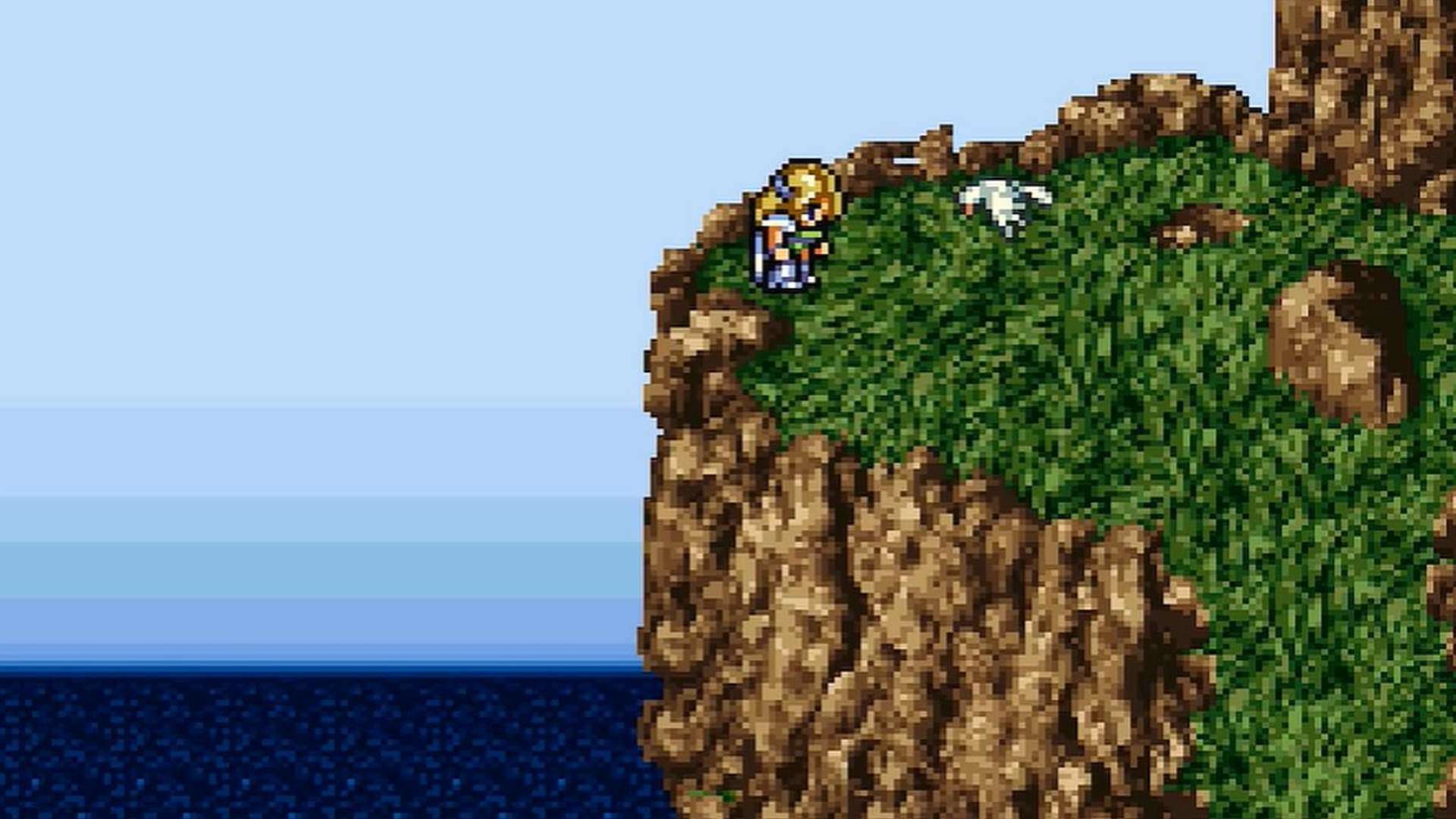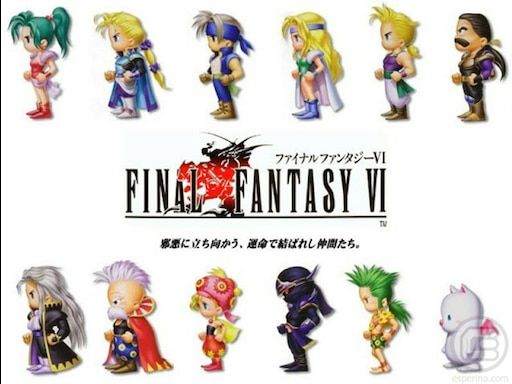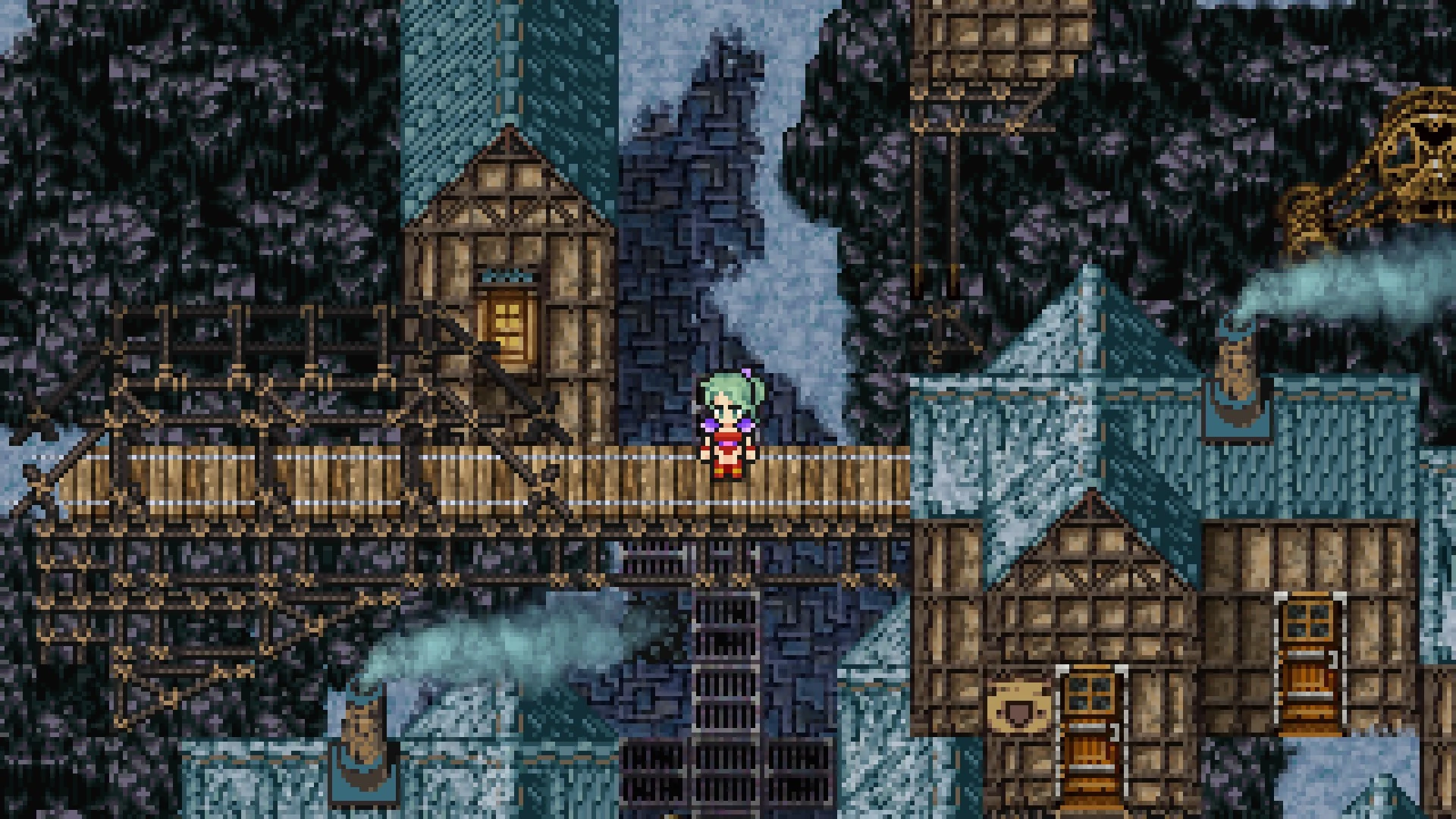Final Fantasy VI Review: The zenith of the Final Fantasy series

Prepare to embark on the journey of a lifetime in Final Fantasy VI, a game that proves to the world that gaming is so much more than it looks at first glance. This game shows that pixels and polygons can birth a meaningful and epic tale of sacrifice, belonging, and resilience against hardships. Final Fantasy VI is a masterpiece that first originated on the Super Nintendo, and even though I finished it for the first time as a teenager in the late 2010s, I will sing this game’s praises until the end of time. This game is not just great for its nostalgia, as I wasn’t alive until 2007, far after this game came out. This game defies the limitations of its era and genre, captivating the player with a timeless narrative, unforgettable characters, and a great battle system. While this game isn’t perfect, it is one of the only games on this planet that I think comes close to perfection… it’s more than a game. It’s an enduring legacy. Now, without further ado, RPG Ranked presents… a Final Fantasy VI Review: The zenith of the Final Fantasy series.
Battle System - 8

This game has a great battle system because, well, this game has an incredible customization system! I love the abilities of each and every character and how they synergize with magic learned from Espers; it adds a lot more depth than it seems at first glance! While the battle system isn’t as fun and unique as the customization surrounding the system, it has enough here that I can confidently say that this is an 8 out of 10 battle system. Though incredibly simple, at the end of the day, Final Fantasy VI has a solid battle system.
Story - 8

Before you come at me with torches and pitchforks for not giving this a ten, I only give it a 9 because, let’s be honest, there’s not much of a prominent story in the World of Ruin. The side stories are phenomenal, but for half the game to not have a main driving narrative? I couldn’t give it a ten. Let’s get into the meat of the incredible and moving story in the World of Balance. The three scenarios were a phenomenal part of the game, allowing the player to have a non-linear narrative that still came together meaningfully and linearly. The scenes leading up to the World of Ruin are some of the best in any RPG ever. The snippets of Shadow’s backstory are phenomenally done and add a ton to his character. The scenes involving Celes and Cid also allow for player choice, a big theme in this game, which catalyzes some fantastic moments that deeply develop Celes as the new protagonist. Terra’s backstory is also very touching and serves as an excellent commentary on racism and political corruption without shoving it in the face of the player, something games like Tales of Symphonia have a hard time pulling off. And, of course, the Opera House sequence is full of infiltration, rebellion, humor, drama, suspense, impersonation, and musical brilliance. This moment not only stands out as one of the best moments in Final Fantasy VI but also in the history of gaming. Overall, the story of Final Fantasy VI is just so good, but since the World of Ruin lacks a forward-driven narrative, it takes up about half the time playing this game... so I couldn’t entirely give this a 10.
Music - 9

While this might not rank as my absolute favorite soundtrack in the series, it’s essential to acknowledge that it is still composed by the phenomenal Nobuo Uematsu. Within this soundtrack, there are undeniably some remarkable tracks that deserve my recognition. Take, for instance, Terra’s Theme, which masterfully establishes the somber yet hopeful tone for the game. Next? The beautifully atmospheric Phantom Train music and the iconic, lively Veldt theme contribute unique dimensions to the soundtrack. Furthermore, the soundtrack offers a glimpse into Uematsu’s versatility with the inclusion of the “Spinach Rag” track, showcasing his ability to create captivating jazz compositions. The Searching for Friends theme is an enchanting world map song, while Shadow’s Theme evokes a sense of intrigue and foreboding. Of course, we must not overlook my two favorite tracks in Final Fantasy VI: Dancing Mad and Aria di Mezzo Carattere. Dancing Mad, in particular, stands out as one of the finest RPG final battle themes, a testament to Uematsu’s prowess, even outshining One-Winged Angel in my personal opinion (with all due respect to Final Fantasy VII fans, if we are including the Advent Children version, I like One-Winged Angel better). Drastically different in tone is Aria di Mezzo Carattere, which is one of my all-time favorite pieces in the series. It plays a pivotal role in the Opera House scene, delivering a heartwarming and climactic experience, one of my favorite moments in the Final Fantasy series. In summary, while this soundtrack undeniably shines, it isn’t nearly the pinnacle of Nobuo Uematsu’s works, so I unfortunately have to assign it a rating of 9 in this category.
Art & Graphics - 8

I’ve always thought this game was the ugliest of the three SNES titles in terms of its original artwork. I don’t even know if I could’ve made it through that with those graphics. I’m sorry for all those who are nostalgic for those graphics; they are pretty terrible… but I digress. I know this is incredibly controversial, but I thought the graphics in the Steam version were gorgeous, and I think the Pixel Remaster graphics are pretty great. I loved in the Steam version the character artwork and the sleekness of the menu screens. I know some people hate this version, but I love it. However, overall, with me not liking the SNES version and the fanbase not enjoying the Steam version, I don’t think this pretty game can go any higher than an 8 because it feels so divisive.
Characters - 9

While Final Fantasy VI boasts a few less-developed characters like Umaro, Gogo, and Strago, most of its cast is exceptional. It stands out as one of the finest character ensembles in any RPG I've ever played! Consider Terra Branford, a mysterious Imperial super-soldier with devastating magic and a rich, spoiler-filled backstory that adds layers of depth. Then there's Locke Cole, the self-proclaimed "treasure hunter" with a compelling backstory and a profoundly meaningful connection with Celes, who happens to be my second favorite character in the game. Celes is a mysterious Magitek Knight, an anti-hero, and the central character in the game's second half, making her one of my favorites in the entire series. However, my favorite character in the game is Shadow, a mysterious mercenary and assassin-for-hire. Despite his enigmatic and dark nature, Shadow manages to be an exceptionally compelling and heartfelt character. There are more than ten other fantastic characters in this game, but for the sake of brevity, I'll leave the joy of discovering or reminiscing about them to you. My primary issue that slightly lowers the character score for this game revolves around how Banon is handled. After the events in Vector, Banon inexplicably vanishes from the rest of the game. He serves as the leader of the resistance, a central element in the game's plot, yet his disappearance lacks any meaningful explanation. Hironobu Sakaguchi's response, stating that he wanted to leave it to the player's imagination, feels like a disservice to such an important character. It comes across as a somewhat lazy narrative choice and is a significant flaw in how the characters are handled in Final Fantasy VI. Initially, I considered giving this a lower score due to this issue, but my overall affection for the game's characters prevailed. Nevertheless, this score is held back from a perfect 10 because of Banon's treatment and the lack of meaningful characterization for a few of the game's main characters.
Customization System - 9

There are three types of Final Fantasy games in my eyes: the character-building games, the changeable job system games, and the fixed job system games. Let me explain. The first type is present in games like Final Fantasy III, Final Fantasy V, Final Fantasy X-2, Final Fantasy XI, Final Fantasy XII, Final Fantasy XIII, Final Fantasy XIV, Final Fantasy IV: 4 Heroes of Light, the Final Fantasy Tactics series, and Final Fantasy Dimensions are all great examples of this type of game. This type of game, I’ll have to admit, is my least favorite type as a whole. While there are some standouts, I much prefer job systems found in games like Octopath Traveler and Blue Dragon—those games just feel so much more balanced and customizable in my eyes. Final Fantasy I, Final Fantasy IV, Final Fantasy IX, Final Fantasy X, Final Fantasy XV, Final Fantasy IV: The After Years and Final Fantasy Dimensions II all fit in this final category in my eyes. The idea of these game’s customization systems is simple… each character fits into some job class and each character feels completely different. Even though this is definitely the most basic, it is my second favorite. The first, most rare, and my favorite are the character-building games. These consist of games like Final Fantasy II, Final Fantasy VII, Final Fantasy VIII, Final Fantasy X, and Final Fantasy XVI. These are the games where everyone can do everything, and only weapon types and ultimate abilities really differentiate the characters. I love all three of these games, and they have phenomenal customization systems, but I could’ve used a bit more differentiation between each character (like how Octopath Traveler II does it). However, even with their flaws, this is still my favorite type of Final Fantasy. So why do I say any of this? Because Final Fantasy VI is the one game I can confidently say blends multiple genres of the Final Fantasy experience, and it does it masterfully. It takes the character building idea of the Materia and Junction systems through its Esper system, but it also takes what I loved about games like Final Fantasy IV—it gives every character a set job, but also gives them the ability to become something new. One of the only other games I can think of that effectively does this is Octopath Traveler II, one of my other favorite RPGs of all-time.
Sidequests - 10

Honestly, this is the game that made me fall in love with completing every sidequest in every RPG I play. This game is a masterpiece in terms of its sidequests, and the only games that can come close to this are some of the Mistwalker games and the Ni No Kuni games… it’s truly rare for there to be such good sidequests in the game. Due to the brilliance of the World of Ruin, Final Fantasy VI becomes an open world game that, quite frankly, is better than any modern open world game I have ever played in my life (I haven’t played Elden Ring or The Witcher, don’t kill me). Searching for your friends, finding different Espers, and hunting for ultimate gear like the Ultimate Weapon and the Cursed Shield are all so incredibly fun. With so many bonus dungeons like the Phoenix Cave, the Cultist’s Tower, the Dragon’s Den, the Ancient Castle, the Zona Eater, the Yeti Cave, the Soul Shrine, and so much more, I can’t stress enough how phenomenal these sidequests are gameplay-wise. And revealing the backstories of Gogo, Locke, and Shadow, as well as continuing the story of Cyan in the Dreamscape? These sidequests also add so much more depth to the story… truly, this is how you do sidequests. You make them fundamental to the story, and make them truly unique. I literally could talk for six more paragraphs about how much I love the sidequests in this game, but for the sake of brevity, I’ll just say it—this is the easiest 10 I’ve ever given in one of my reviews.
Locations - 10

On top of all the amazing World of Ruin locations I just mentioned, there are so many unique locations in the World of Balance, too. Add these all together, and you have an array of locations you will never forget. From Narshe, a charming (albeit dark) mining town nestled in the snow-capped mountains that starts the game off with a bang, to Figaro Castle, a technological marvel of a castle that can dig underground and pop up in different locations worldwide. From Vector, the Imperial capital, a bustling city with a dark underbelly that showcased the stark contrast between the oppressive Empire and the free-spirited heroes, to Zozo, easily one of the best towns in the Final Fantasy series full of scoundrels and con artists. From the Opera House, home to one of the best moments in the series, to the Magitek Research Facility, up there with the Shinra Headquarters as one of the best areas in the series. From Thamasa, a quiet, secluded village where magic is isolated from the outside world, yet forbidden, to the Floating Continent, a breathtaking location high above the world with phenomenal story cutscenes. From the Phantom Train, a beautiful and eerie dungeon full of undeniable charm, to the Sealed Cave, home of the Espers, and many story beats that reveal Terra’s backstory. And not a single one of those is in the World of Ruin. This game is just that good. If I said the sidequests were the easiest 10 I’ve given in a review, this would be the second easiest. This game’s locations are just that good.
Quality of Life - 9.5

This game doesn't have significant quality-of-life issues, but a couple can be somewhat annoying. For example, you must return to the Airship whenever you want to change your party members, which can be frustrating. Fortunately, this was improved in later entries like VII, VIII, X, and so on. It's still perplexing that Final Fantasy IX also required you to return to the Airship like in this game, but that's a different discussion. Additionally, the game's world map is expansive, with numerous locations and a somewhat dated map interface, making it challenging to keep track of all these places without an online map. However, these two issues are the most noteworthy, and overall, Final Fantasy VI has aged remarkably well. While it's not without its imperfections (very few games are), the quality of life problems here are almost negligible, so this score is well-deserved.
The Verdict

Fun Factor: 9.5
Overall Score: 90%
Letter Rating: S+
I know I am harsh, giving one of the greatest games of all time a 90%. But no game is without its flaws… but this game comes pretty damn close to being one of the most perfect games ever made. Final Fantasy VI is a masterpiece through and through, and the fact that this game was made (let alone on the SNES) is insane. While some sing the praises of Final Fantasy VII and say it is the definitive best game in the series, I couldn’t disagree more—Final Fantasy VII doesn’t even crack the top five Final Fantasy games for me, while this holds up in my top 10 favorite games ever made. Even if you hate RPGs and turn-based combat, I genuinely think you can find something to love in this masterpiece of an RPG. This game will impact you emotionally, it will captivate you with its nonlinearity that outclasses even the most open-world games of the modern era, its phenomenal protagonists and villains, and it will prove to any skeptics that classic turn-based RPGs are something that should never be lost to time. Final Fantasy VI is transcendent—it’s one of those games that isn’t just a game but an experience. And it isn’t just an experience, but an emotional journey you will never forget. And for that, Final Fantasy VI should be recommended to anyone and everyone who likes video games of any genre, not just RPGs.
Want to check out Final Fantasy VI and support our site without any cost on your behalf? Buy Final Fantasy VI at the affiliate links here :) The Steam version is my personal favorite because it has the most content and such, but since that no longer available, I'd suggest the GBA version first, with the Pixel Remaster as a distant second. But really, you can't go wrong either way.
Final Fantasy VI (SNES)
Final Fantasy VI (PS1)
Final Fantasy VI (GBA, used)
Final Fantasy VI (GBA, new)
Final Fantasy VI (Pixel Remaster)
Final Fantasy (Pixel Remaster)
Primary Version: Final Fantasy VI (GBA)